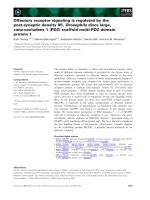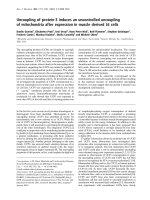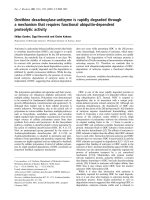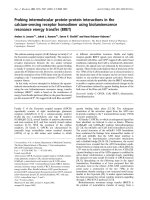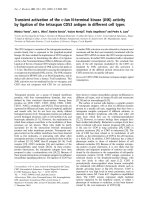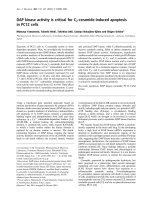Báo cáo y học: "Fibroblast activation protein is expressed by rheumatoid myofibroblast-like synoviocytes" ppt
Bạn đang xem bản rút gọn của tài liệu. Xem và tải ngay bản đầy đủ của tài liệu tại đây (4.78 MB, 11 trang )
Open Access
Available online />Page 1 of 11
(page number not for citation purposes)
Vol 8 No 6
Research article
Fibroblast activation protein is expressed by rheumatoid
myofibroblast-like synoviocytes
Stefan Bauer
1
, Michael C Jendro
2
, Andreas Wadle
1
, Sascha Kleber
1
, Frank Stenner
1
,
Robert Dinser
3
, Anja Reich
2
, Erica Faccin
1
, Stefan Gödde
4
, Harald Dinges
5
, Ulf Müller-Ladner
3
and
Christoph Renner
1
1
Oncology Department, UniversitätsSpital Zürich, Rämistrasse 100, 8091 Zürich, Switzerland
2
Med. Department I, Universität des Saarlandes, Kirrbergstrasse, 66421 Homburg/Saar, Germany
3
Department of Internal Medicine and Rheumatology, University of Giessen and Kerckhoff-Clinic, Benekestrasse 2–8, 61231 Bad Nauheim, Germany
4
Orthopedic Department, Universität des Saarlandes, Kirrbergstrasse, 66421 Homburg/Saar, Germany
5
Orthopedic Clinic, Westpfalz-Klinikum, Im Flur 1, 66869 Kusel, Germany
Corresponding author: Stefan Bauer,
Received: 31 Mar 2006 Revisions requested: 10 May 2006 Revisions received: 2 Oct 2006 Accepted: 14 Nov 2006 Published: 14 Nov 2006
Arthritis Research & Therapy 2006, 8:R171 (doi:10.1186/ar2080)
This article is online at: />© 2006 Bauer et al.; licensee BioMed Central Ltd.
This is an open access article distributed under the terms of the Creative Commons Attribution License ( />),
which permits unrestricted use, distribution, and reproduction in any medium, provided the original work is properly cited.
Abstract
Fibroblast activation protein (FAP), as described so far, is a type
II cell surface serine protease expressed by fibroblastic cells in
areas of active tissue remodelling such as tumour stroma or
healing wounds. We investigated the expression of FAP by
fibroblast-like synoviocytes (FLSs) and compared the synovial
expression pattern in rheumatoid arthritis (RA) and osteoarthritis
(OA) patients. Synovial tissue from diseased joints of 20
patients, 10 patients with refractory RA and 10 patients with
end-stage OA, was collected during routine surgery. As a result,
FLSs from intensively inflamed synovial tissues of refractory RA
expressed FAP at high density. Moreover, FAP expression was
co-localised with matrix metalloproteinases (MMP-1 and MMP-
13) and CD44 splice variants v3 and v7/8 known to play a major
role in the concert of extracellular matrix degradation. The
pattern of signals appeared to constitute a characteristic feature
of FLSs involved in rheumatoid arthritic joint-destructive
processes. These FAP-expressing FLSs with a phenotype of
smooth muscle actin-positive myofibroblasts were located in the
lining layer of the synovium and differ distinctly from Thy-1-
expressing and non-proliferating fibroblasts of the articular
matrix. The intensity of FAP-specific staining in synovial tissue
from patients with RA was found to be different when compared
with end-stage OA. Because expression of FAP by RA FLSs has
not been described before, the findings of this study highlight a
novel element in cartilage and bone destruction of arthritic joints.
Moreover, the specific expression pattern qualifies FAP as a
therapeutic target for inhibiting the destructive potential of
fibroblast-like synovial cells.
Introduction
Fibroblast activation protein (FAP) is an M
r
95-kDa, cell sur-
face-bound, type II transmembrane glycoprotein and belongs
to the family of serine prolyl oligopeptidases. Comparison of
amino acid sequences indicates that FAP is essentially identi-
cal to seprase [1] and closely related to dipeptidylpeptidase IV
(DPP IV), also known as CD26, another type II integral mem-
brane protein [2]. These exoproteases cleave NH
2
-terminal
dipeptides from polypeptides with l-proline or l-alanine in the
penultimate position. In addition, FAP was found to bear colla-
genase activity in vitro [1,3]. Peptidase activity of FAP, in addi-
tion to various families of proteolytic enzymes such as matrix or
disintegrin metalloproteases that serve as major collagenases,
contributes to extracellular matrix (ECM) degradation [4,5].
This not only is a fundamental property of normal tissue repair
and remodelling but also is involved in the pathological proc-
esses of invasive growth. It correlates with the expression of
FAP in granulation tissue of healing wounds and in more than
90% of human epithelial carcinomas [6]. Consistent with its
mesenchymal origin, FAP is also occasionally expressed by
CIA = collagen-induced arthritis; DPP IV = dipeptidylpeptidase IV; ECM = extracellular matrix; FAP = fibroblast activation protein; FLS = fibroblast-
like synoviocyte; GADPH = glyceraldehyde-3-phosphate dehydrogenase; HPRT = hypoxanthine phosphoribosyltransferase; IgG = immunoglobulin
G; MMP = matrix metalloproteinase; OA = osteoarthritis; RA = rheumatoid arthritis; SMA = smooth muscle actin.
Arthritis Research & Therapy Vol 8 No 6 Bauer et al.
Page 2 of 11
(page number not for citation purposes)
bone and soft tissue sarcomas [7]. Immunohistochemical
staining of colorectal carcinomas and breast cancer [4,8] con-
firmed the specific expression of FAP by tumour stroma fibrob-
lasts but not by malignant cells themselves. In contrast, resting
fibrocytes in normal adult tissue generally lack detectable FAP
expression [7].
Rheumatoid arthritis (RA) is a chronic inflammatory disease of
unknown aetiology and is characterised by hyperplasia and
chronic inflammation of the synovial membranes that invade
deeply into the articular cartilage and bone. Activated fibrob-
last-like synoviocytes (FLSs) in the lining layer of the synovium
are among the dominant cell types involved in pannus forma-
tion and are key players in joint destruction [9,10]. Rheumatoid
FLSs have been shown to proliferate in an anchorage-inde-
pendent manner and express increased proliferation markers
and matrix-degrading enzymes when compared with FLSs
from patients with osteoarthritis (OA) [11-13]. Expression of
the CD44v7/8 epitopes contributes to the proliferative behav-
iour of FLSs obtained from patients with RA, whereas expres-
sion of variants containing v3 is linked with their increased
invasive capacity [14-16]. Matrix metalloproteases (MMPs)
have been shown to be essential for degradation of articular
matrix, with MMP-1 and MMP-13 being important candidates
for joint destruction in RA [17,18]. However, except for metal-
locollagenolytic activities, invasion of migratory fibroblasts into
connective tissue involves serine types of cell surface pro-
teases [5]. Among the exoproteases that may cooperate with
interstitial collagenase are groups of serine prolyl peptidases,
including DPP IV/CD26 and FAP/seprase [4,19]. Gene
expression signatures of FLSs demonstrate the association of
a high inflammatory state of synovitis and the presence of a
myofibroblast-like molecular phenotype [20]. These myofi-
broblasts were identified in cultures from patients with RA [21]
as well as by immunohistochemical staining in the intimal lining
layer of RA synovial tissues [20].
Here, we report the concomitant involvement of FAP together
with metalloproteases and CD44 variants in the lining layer of
rheumatoid synovium contributing to the characteristics of
FLSs with myofibroblastic phenotype. In addition, synovial tis-
sue analysis revealed a strong correlation between inflamma-
tory synovitis and FAP expression.
Materials and methods
Patients
Synovial tissues were collected during routine orthopaedic
surgery from 10 consecutive patients with end-stage OA and
10 consecutive patients with refractory destructive RA who
underwent joint replacement. The latter patient population ful-
filled the American College of Rheumatology criteria for RA
[22]. The mean age of patients with RA was 62 years (eight
females and two males). Mean laboratory parameters were
erythrocyte sedimentation rate of 41 mm/hour and leucocyte
count of 8.95 × 10
3
per microlitre, and 90% of patients were
rheumatoid factor-positive. All patients gave informed consent,
and the study protocol was approved by the local ethics
committees.
Cell lines and reagents
RPMI 1640 medium (supplemented with 10% [vol/vol] heat-
inactivated foetal calf serum, penicillin [100 units per millilitre],
streptomycin [0.1 mg/ml], and glutamine [0.3 mg/ml]) (all from
Gibco, now part of Invitrogen Corporation, Carlsbad, CA,
USA) was used as standard medium. HT1080 FAP-trans-
fected (HT1080 FAP) and mock-transfected (HT1080 par)
cells were previously described [23]. The following antibodies
were obtained from the following sources: Murine F19 (mouse
anti-human FAP monoclonal antibody) was obtained from the
Ludwig Institute for Cancer Research (New York, NY, USA).
Anti-human CD90 (Thy-1; clone AS02) and biotin-SP-conju-
gated rabbit anti-mouse immunoglobulin G (IgG) were pur-
chased from Dianova GmbH (Hamburg, Germany). Mouse
anti-human CD44v3 (clone VFF-327) and CD44v7/8 (clone
VFF-17) were purchased from Serotec Ltd. (Oxford, UK), and
mouse anti-human smooth muscle actin (SMA) (clone 1A4)
was obtained from Dako Denmark A/S (Glostrup, Denmark).
Goat anti-human MMP-1 (C-18) and MMP-13 (D-17) were
purchased from Santa Cruz Biotechnology, Inc. (Santa Cruz,
CA, USA). Biotinylated rabbit anti-goat IgG was purchased
from Vector Laboratories (Burlingame, CA, USA).
RNA isolation and reverse transcription-assisted
polymerase chain reaction
FAP- or mock-transfected HT1080 cells, tumour samples from
patients with breast cancer, or a part of collected synovial tis-
sue was homogenised immediately after surgery by using a tis-
sue tearer, and total RNA was extracted (RNeasy; Qiagen
GmbH, Hilden, Germany) following the manufacturer's
instructions. Total amount of RNA was quantified by spectro-
photometry, and 500 ng was used for first-strand cDNA syn-
thesis using RevertAid™ H Kit (Fermentas GmbH, St. Leon-
Rot, Germany). The following primers were used for amplifica-
tion of specific cDNA fragments as described previously [24]:
The FAP polymerase chain reaction (PCR) product was gen-
erated with 5'-GTTATTGCCTATTCCTATTATG-3' and 5'-
GTCCATCATGAAGGGTGGAAA-3'. The MMP-1 PCR prod-
uct was generated with 5'-CTGAAGGTGATGAAGCAGCC-
3' and 5'-AGTCCAAGAGAATGGCCGAG-3'. The MMP-13
PCR product was generated with 5'-CTATGGTCCAGGA-
GATGAAG-3' and 5'-AGAGTCTTGCCTGTATCCTC-3'. The
GADPH (glyceraldehyde-3-phosphate dehydrogenase) PCR
product was generated with 5'-GTGAAGGTCGGAGT-
CAACGGATTT-3' and 5'-CTCCTTGGAGGCCATGT-
GGGCCAT-3'. cDNA was amplified with 1.25 units of Taq
DNA polymerase with 2.5 ml of 10× standard taq buffer (Ther-
mopol; New England Biolabs, Ipswich, MA, USA) in a final vol-
ume of 25 μl containing 0.5 μl of nucleosidtriphosphate (10
mM), 0.5 μl of each primer (10 μM), and Aqua dest. PCR
amplification was carried out on a PTC-200 thermocycler (MJ
Available online />Page 3 of 11
(page number not for citation purposes)
Research, now part of Bio-Rad, Hercules, CA, USA) with the
following profile: 95°C for 5 minutes, annealing for 60 sec-
onds, and extension at 72°C for 1 minute. The number of
cycles and the annealing temperature depended on the prim-
ers used: (a) FAP (55°C, 30 cycles), (b) MMP-1, (c) MMP-13
(62°C, 40 cycles), and (d) GADPH (62°C, 25 cycles). Aliquots
(20 μl) of each PCR product were separated on a 1.5% agar-
ose gel and visualised by ethidium bromide staining (Sigma-
Aldrich, St. Louis, MO, USA). Cell lines or breast cancer sam-
ples served as controls.
Quantitative real-time PCR
Measurement was performed on LightCycler detection sys-
tems (Roche, Heidelberg, Germany) using the relative quanti-
fication method with external standard (LightCycler technical
note no. LC 10/update 2003; Roche). The endogenous con-
trol gene hypoxanthine phosphoribosyltransferase 1 (HPRT1;
NM_000194) and the FAP gene (NM_004460) were meas-
ured by quantitative reverse transcription-PCR using the Gen-
Globe™ technology from Qiagen GmbH and an HPRT
quantification kit (Roche). Design of specific HPRT and human
FAP primers was executed by Qiagen GmbH (QuantiTect
Primer Assay, QT00074963) and Roche. Assay conditions for
the real-time PCR were adjusted using an optimised PCR pro-
tocol with the following profile: initial activating of Taq-
polymerase at 95°C for 15 minutes, followed by 35 cycles with
denaturation at 95°C for 15 seconds, annealing at 60°C for 15
seconds, and extension at 72°C for 20 seconds. Samples
from all patients (10 patients with RA and 10 patients with
OA), controls, and standards were run in triplicate. The
amount of the housekeeping gene HRPT was used to corre-
late FAP expression employing LightCycler analysis software.
Immunohistochemistry
Remaining portions of collected samples were embedded in
Tissue-Tek OCT medium (Miles Diagnostics, Elkhart, IN,
USA), snap-frozen in liquid nitrogen, and then stored at -80°C
for immunohistochemical analysis. Sequential 5-μm sections
were placed on SuperFrost
®
Plus microscope slides (Menzel-
Gläser, Braunschweig, Germany). Slides were fixed in cold
acetone (4°C for 10 minutes), air-dried, rehydrated in phos-
phate-buffered saline, and then blocked using a Biotin Block-
ing System (Dako North America, Inc., Carpinteria, CA, USA).
Before the primary antibody (anti-human FAP, anti-human Thy-
1, or irrelevant isotype-matched IgG, 1:200, incubated for 60
minutes at room temperature; anti-human CD44v3, 1:50; anti-
human CD44v7/8, 1:200; anti-human SMA, 1:50; and anti-
human MMP-1, anti-human MMP-13, or irrelevant isotype-
matched IgG, 1:100, incubated overnight at 4°C) was added,
slides were blocked with rabbit serum from the Vectastain
®
ABC Kit (Vector Laboratories). The biotinylated secondary
antibody (rabbit anti-mouse IgG [1:500] or rabbit anti-goat
IgG [2 μg/ml]) and the preformed avidin-biotinylated horserad-
ish peroxidase P-complex (ABC reagent) were used accord-
ing to the manufacturer's instructions. The antibody-ABC
complex was visualised with a 3-amino-9 ethylcarbazole
(AEC) (Sigma-Aldrich)-based chromagen, resulting in a pink-
brown colouration of antigen-positive cells. Simultaneous
staining of FAP and SMA was performed using the DakoCyto-
mation EnVision Doublestain-Kit (code K1395; Dako North
America, Inc.) according to the manufacturer's instructions.
FAP was stained first with DAB (3,3'-diaminobenzidin) fol-
lowed by colouration of SMA with fast red. All slides were
counterstained for approximately 2 to 5 minutes with Meyer's
haematoxylin. Final slide adjustment was performed using
Adobe Photoshop Elements (Adobe Systems GmbH, Unter-
schleissheim, Munich, Germany).
Statistics
Comparison of FAP gene expression measured by real-time
PCR between synovial tissue samples taken from patients with
end-stage OA or severe RA was performed with Mann-Whit-
ney test (U test). P values < 0.01 were considered statistically
significant.
Results
FAP mRNA expression and protein transcription profile
Synovial tissue was collected from 20 patients, 10 patients
with refractory RA and 10 patients with end-stage OA. mRNA
extraction and cDNA synthesis were performed immediately
after surgery. Quantitative real-time PCR analysis was estab-
lished to compare the levels of FAP gene expression in syno-
vial samples of both entities. FAP gene expression was
significantly higher in RA synovial samples (p < 0.01; Figure
1a). High specificity of PCR is demonstrated by agarose gel
electrophoresis and melting curve analysis (data not shown).
Furthermore, all samples were analysed for mRNA transcripts
coding for fragments of FAP (741 bp), MMP-1 (428 bp), and
MMP-13 (390 bp). Amplification of a GADPH fragment with
the expected size of 995 bp served as control. Positive PCR
controls were obtained from cDNA derived from FAP-trans-
fected HT1080 cells (FAP) or breast cancer tumour samples
(MMP-1 and MMP-13). Amplification of cDNA derived from
mock-transfected HT1080 cells was negative for specific frag-
ments. Analysis of synovial samples from patients with severe
RA (Figure 1b, column A) or end-stage OA (Figure 1b, column
B) demonstrates ubiquitary expression of MMP-1, MMP-13,
and FAP. However, expression was more pronounced in
refractory RA samples. Differences in transcription of FAP
gene were confirmed by immunohistochemistry. Correspond-
ing to the significant difference in gene expression analysis,
FAP positivity is much more pronounced in rheumatoid syno-
vial samples than in the osteoarthritic counterparts (Figure 2).
Association of FAP with activation markers
The histomorphological characterisation of the synovial lining
layer by FAP expression is accompanied by the accumulation
of other activation markers in this area. The phenotypic mark-
ers analysed in this context were MMP-1 and MMP-13,
together with the v3 and v7/8 splice variants of CD44, which
Arthritis Research & Therapy Vol 8 No 6 Bauer et al.
Page 4 of 11
(page number not for citation purposes)
are instrumental in ECM alteration in malignancies and already
known to be expressed in the synovial membranes of diseased
joints (Figures 3 and 4). The expression signature character-
ises the area of FAP-expressing cells as the centre of high
inflammatory activity in the rheumatoid synovium (Figures 4
and 5). In contrast to the synovial lining layer of rheumatoid
joints, osteoarthritic joints show limited staining for MMPs and
CD44 variants, with only minor expression of MMP-13 and
CD44v7/8 (Figures 3 and 5).
Association of FAP with fibroblast markers
RA and OA synovial fibroblasts express CD90 (Thy-1) on their
surface. However, there is a distinct fibroblast population in
the lining layer of the synovium from both patient groups, com-
pletely lacking Thy-1 surface expression. This distinct synovial
cell population is clearly characterised by cell surface expres-
sion of FAP (Figure 6) which is paralleled by cell surface
expression of activation markers (Figure 5). Fibroblasts with
myofibroblastic phenotype are a known source of proteolytic
Figure 1
Expression of fibroblast activation protein (FAP) mRNAExpression of fibroblast activation protein (FAP) mRNA. Synovial tissue samples were collected by orthopaedic surgery from 10 patients with end-
stage osteoarthritis (OA) who underwent joint replacement or from 10 patients with destructive refractory rheumatoid arthritis (RA). (a) Quantifica-
tion of FAP gene expression was determined by real-time polymerase chain reaction (PCR) as described in Materials and methods. The data are pre-
sented relative to HPRT and are graphically visualised as box-and-whisker plots. Expression of FAP gene is significantly higher in the synovial
samples of patients with RA compared with OA synovial samples (p < 0.01). (b) Reverse transcription-PCR analysis of FAP, matrix metalloprotein-
ase (MMP)-1, and MMP-13. Synovial tissue samples were collected from patients with destructive refractory RA (column A, lanes 1 to 5) or from
patients with end-stage OA (column B, lanes 1 to 5). Extraction control was performed with GAPDH PCR. Positive controls (P) were fibroblasts for
MMP-1, pooled breast cancer samples for amplification of MMP-13 and p53, and FAP-transfected HT1080 cells for FAP. GAPDH, glyceraldehyde-
3-phosphate dehydrogenase; HPRT, hypoxanthine phosphoribosyltransferase; L, DNA ladder; N, negative controls.
Available online />Page 5 of 11
(page number not for citation purposes)
enzymes that are involved in ECM deposition. A reliable marker
for identifying this subpopulation is anti-SMA. In addition to
staining of perivascular smooth muscle cells,
immunohistochemistry revealed the expression of SMA by
FAP-positive FLSs in the intimal lining layer (Figure 6), and the
simultaneous expression of both antigens could be demon-
strated by double-staining technique (Figure 7). As a result,
expression pattern and staining intensity of SMA are consider-
ably different between the rheumatoid and the osteoarthritic
synovium. Furthermore, either the expression density of activa-
tion markers or their staining intensity differs between the sam-
ples of osteoarthritic synovial tissue from different patients.
With regard to the degree of inflammation, immunohistochem-
ical analysis of synovial samples from patients with refractory
RA showed homogenous expression pattern and staining
intensity.
Discussion
The main finding of our study is the demonstration that FAP is
expressed by synovial fibroblasts in patients with RA and OA.
It is well established that FAP is expressed mainly on the sur-
face of mesenchymal cells that are involved in epithelium-mes-
enchyme interactions contributing to tissue remodelling. So
far, FAP-expressing fibroblasts in human have been detected
only in granulation tissue of healing wounds [25], desmoplas-
tic reactions [26], and the reactive stroma of malignant tissue
[27]. Resting fibrocytes in normal adult tissue generally lack
expression of FAP [6]. However, observations from a clinical
Phase I study with a humanised anti-FAP antibody might retro-
spectively lead to the conclusion that FAP could also be
present in human joints. Studying the biodistribution of a
humanised anti-FAP antibody in patients with advanced or
metastatic FAP-positive cancer, a minor low-grade uptake in
the knees and shoulders of three patients without clinical
symptoms of arthritis was observed. Unfortunately, no further
explanation or discussion of this observation was presented,
and in particular it is unknown whether these patients were
suffering from OA [28].
Apart from the detection of FAP-positive FLSs in RA and OA,
substantial differences between both diseases regarding this
cell type are apparent. First, FAP-expressing FLSs in RA syn-
ovial tissue are more frequent and predominantly localised in
the lining layer. Second, FAP expression by RA FLSs is mainly
by FLSs of the myofibroblastic phenotype. Third, RA joints
show an accumulation of MMP-1 and MMP-13, in concert with
the v3 and v7/8 splice variants of CD44 in the synovial lining
layer. In contrast, osteoarthritic joints show minor expression
of MMPs and CD44 variants. Because FAP expression is
much more pronounced in RA tissue, this might be related to
the degree of synovial inflammation, as has been already dem-
onstrated for MMPs and FAP in collagen-induced arthritis
(CIA). In mice, analysis of CIA gene expression profiles
revealed a seven-fold increase in FAP, DPP IV, and MMP gene
expression in inflamed paws as compared with non-inflamed
paws [29,30]. Furthermore, DPP IV is a structural homologue
to FAP, and seprase and FAP are known to build heteromeric
complexes with DPP IV/CD26 to act coordinately in ECM
breakdown [5].
The fact that FLSs in the rheumatoid synovium express FAP
intensively does not allow definitive conclusions regarding the
functional enzymatic role in ECM degradation, because sub-
strate specificity of FAP remains unknown [31]. However, the
probability of its contribution to exacerbating joint
Figure 2
Cell surface expression of fibroblast activation protein (FAP)Cell surface expression of fibroblast activation protein (FAP). Gene
expression analysis is completed by immunohistochemical staining.
FAP-specific staining was performed on synovial samples of five indi-
viduals of each entity (rheumatoid arthritis [RA] and osteoarthritis
[OA]), demonstrating the stronger expression at the protein level in the
inflamed synovia of patients with refractory RA. Magnification, ×100.
Arthritis Research & Therapy Vol 8 No 6 Bauer et al.
Page 6 of 11
(page number not for citation purposes)
Figure 3
Immunohistochemical analysis of activation markers in synovial membranes of osteoarthritisImmunohistochemical analysis of activation markers in synovial membranes of osteoarthritis. Phenotypic markers that are instrumental in extracellular
matrix alteration are detectable only at a low level (MMP-1, CD44v7/8) in areas that are slightly FAP-positive. Magnification, ×400. FAP, fibroblast
activation protein; MMP, matrix metalloproteinase.
Figure 4
Immunohistochemical analysis of activation markers in synovial membranes of rheumatoid arthritisImmunohistochemical analysis of activation markers in synovial membranes of rheumatoid arthritis. Expression of fibroblast activation protein (FAP) is
accompanied by accumulation of activation markers (MMP-1 and MMP-13) and splice variants of CD44 (v3 and v7/8) that are known to correlate
with the degree of inflammation and that are involved in extracellular matrix deposition. Magnification, ×400. MMP, matrix metalloproteinase.
Available online />Page 7 of 11
(page number not for citation purposes)
degeneration was recently discussed [32] and is supported by
our results. Characterisation of the synovial lining layer in
patients with RA revealed that FAP expression is accompa-
nied by accumulation of other degradation markers that are
predominantly found in this area. MMP-1 and MMP-13 as well
as the v3 and v7/8 splice variants of CD44 are instrumental in
Figure 5
Comparison of immunohistochemical detection of activation markersComparison of immunohistochemical detection of activation markers. Analysis of representative areas of synovial tissue samples taken from patients
with end-stage osteoarthritis (OA) or refractory rheumatoid arthritis (RA) is shown. Expression pattern and staining intensity of RA samples represent
the stronger intensity of synovial inflammation when compared with OA samples. Magnification, ×400. FAP, fibroblast activation protein; MMP,
matrix metalloproteinase.
Arthritis Research & Therapy Vol 8 No 6 Bauer et al.
Page 8 of 11
(page number not for citation purposes)
ECM remodelling in malignancies and are also already known
to be present in the synovial membranes of diseased joints
[14-18]. In addition, fibroblasts of the myofibroblastic pheno-
type seem to be the major cell type expressing FAP in patients
with RA. They are also an important source of other proteolytic
enzymes and are generally thought to be responsible for ECM
degradation [20,33,34]. A reliable marker for identifying this
subpopulation is anti-SMA. Immunohistochemistry revealed
the expression of anti-SMA by FAP-positive FLSs in the intimal
lining layer. The expression signature characterises the area of
FAP-expressing myofibroblastic cells as the centre of high-
inflammation activity in the rheumatoid synovium and discrimi-
nates from Thy-1-positive non-proliferating fibroblasts in the
synovial matrix [35].
The potential value of FAP as a therapeutic target in RA and
OA is twofold. First, if the proteolytic activity of FAP contrib-
utes to ECM degradation, inhibition is an attractive goal. In this
context, it needs to be noted that suppression of enzymatic
activity resulted in potent antitumour effects and could
augment antibody-dependent cell-mediated cytotoxicity in
murine tumour models [36,37]. Second, FAP appears to be a
valuable marker for the identification of FLSs with the highest
proteolytic activity. The genetically stable and restricted
expression of FAP [6] leads to the establishment of several
preclinical strategies for tumour therapy [23,38,39]. The con-
cept of anti-FAP antibody-based cancer immunotargeting has
even been proven in a clinical Phase I dose-escalation study
[28].
Despite the elucidation of FLSs as key players in joint inflam-
mation and proteolytic enzymes like MMPs as markers respon-
sible for ECM degradation, no anti-fibroblast-directed therapy
is currently available. Approaches to inhibit the joint-destruc-
tive process in RA by elimination or inhibition of one proteolytic
enzyme did not produce sufficient results in clinical trials,
Figure 6
Immunohistochemical characterisation of fibroblast populationsImmunohistochemical characterisation of fibroblast populations. Collected samples were snap-frozen, and sequential sections were stained for
expression of Thy-1, fibroblast activation protein (FAP), or smooth muscle actin (SMA). Antigen-positive cells were identified by pink-brown coloura-
tion. Tissue samples of both entities, rheumatoid arthritis (RA) and osteoarthritis (OA), show distinct synovial fibroblast populations. Associated
expression of SMA and FAP distinguishes myofibroblasts of the intimal synovial lining from Thy-1-positive fibroblasts or only SMA-expressing
perivascular smooth muscle cells. Staining of anti-human FAP and anti-human SMA is more intense in RA tissue samples when compared with OA.
Magnification, ×100.
Available online />Page 9 of 11
(page number not for citation purposes)
regardless of supportive in vivo results [40-42]. The difference
between the targeting strategies of these approaches and
FAP-specific targeting results from the substantial potential of
FAP as a specific marker for synovial fibroblasts in RA. There-
fore, targeting strategies could involve both inhibiting the role
of the enzyme in tissue remodelling and focusing antibody-
mediated cytotoxic activity on this synovial cell type to eradi-
cate a central cellular mediator of the joint-destructive process
[43].
Conclusion
Expression of FAP by RA FLSs has not been described so far
and highlights an implication in cartilage and bone destruction
of arthritic joints. The specific expression pattern qualifies FAP
as a therapeutic target for eradicating the destructive fibrob-
last-like synovial cell type.
Competing interests
The authors declare that they have no competing interests.
Authors' contributions
SB, MCJ, and CR helped to conceive, design, and coordinate
the study and draft the manuscript. RD and FS helped to con-
ceive the study and carried out synovial membrane prepara-
tions. AR coordinated human synovium collection and carried
out immunohistochemistry and cell culture. EF performed the
double-staining. AW and SK carried out preparation of cDNA,
RT-PCR, and LightCycler PCR. SG and HD collected human
Figure 7
Double-staining of fibroblast activation protein (FAP) and smooth muscle actin (SMA)Double-staining of fibroblast activation protein (FAP) and smooth muscle actin (SMA). Synovial tissue samples from patients with destructive rheu-
matoid arthritis were stained to demonstrate the simultaneous expression of both antigens. FAP-positive fibroblasts in the intimal synovial lining were
coloured brown (DAB [3,3'-diaminobenzidin]). Coexpression of SMA is visualised in red (fast red). Magnification, ×400.
Arthritis Research & Therapy Vol 8 No 6 Bauer et al.
Page 10 of 11
(page number not for citation purposes)
synovial tissue from joint replacement surgery. UM-L helped to
coordinate the study and draft the manuscript. All authors read
and approved the final manuscript.
Acknowledgements
SB is funded by the University of the Saarland and Europrofession e.V.
UM-L is funded by the German Research Society (DFG, Mu 1383/3-3).
CR is funded by Europrofession e.V. and the Ludwig Institute for Cancer
Research.
References
1. Goldstein LA, Ghersi G, Pineiro-Sanchez ML, Salamone M, Yeh Y,
Flessate D, Chen WT: Molecular cloning of seprase: a serine
integral membrane protease from human melanoma. Biochim
Biophys Acta 1997, 1361:11-19.
2. Morimoto C, Schlossman SF: The structure and function of
CD26 in the T-cell immune response. Immunol Rev 1998,
161:55-70.
3. Jones B, Adams S, Miller GT, Jesson MI, Watanabe T, Wallner BP:
Hematopoietic stimulation by a dipeptidyl peptidase inhibitor
reveals a novel regulatory mechanism and therapeutic treat-
ment for blood cell deficiencies. Blood 2003, 102:1641-1648.
4. Park JE, Lenter MC, Zimmermann RN, Garin-Chesa P, Old LJ, Ret-
tig WJ: Fibroblast activation protein, a dual specificity serine
protease expressed in reactive human tumor stromal
fibroblasts. J Biol Chem 1999, 274:36505-36512.
5. Ghersi G, Dong H, Goldstein LA, Yeh Y, Hakkinen L, Larjava HS,
Chen WT: Regulation of fibroblast migration on collagenous
matrix by a cell surface peptidase complex. J Biol Chem 2002,
277:29231-29241.
6. Garin-Chesa P, Old LJ, Rettig WJ: Cell surface glycoprotein of
reactive stromal fibroblasts as a potential antibody target in
human epithelial cancers. Proc Natl Acad Sci U S A 1990,
87:7235-7239.
7. Rettig WJ, Garin-Chesa P, Beresford HR, Oettgen HF, Melamed
MR, Old LJ: Cell-surface glycoproteins of human sarcomas:
differential expression in normal and malignant tissues and
cultured cells. Proc Natl Acad Sci U S A 1988, 85:3110-3114.
8. Scanlan MJ, Raj BK, Calvo B, Garin-Chesa P, Sanz-Moncasi MP,
Healey JH, Old LJ, Rettig WJ: Molecular cloning of fibroblast
activation protein alpha, a member of the serine protease fam-
ily selectively expressed in stromal fibroblasts of epithelial
cancers. Proc Natl Acad Sci U S A 1994, 91:5657-5661.
9. Firestein GS: Invasive fibroblast-like synoviocytes in rheuma-
toid arthritis. Passive responders or transformed aggressors?
Arthritis Rheum 1996, 39:1781-1790.
10. Pap T, van der Laan WH, Aupperle KR, Gay RE, Verheijen JH,
Firestein GS, Gay S, Neidhart M: Modulation of fibroblast-medi-
ated cartilage degradation by articular chondrocytes in rheu-
matoid arthritis. Arthritis Rheum 2000, 43:2531-2536.
11. Qu Z, Garcia CH, O'Rourke LM, Planck SR, Kohli M, Rosenbaum
JT:
Local proliferation of fibroblast-like synoviocytes contrib-
utes to synovial hyperplasia. Results of proliferating cell
nuclear antigen/cyclin, c-myc, and nucleolar organizer region
staining. Arthritis Rheum 1994, 37:212-220.
12. Bucala R, Ritchlin C, Winchester R, Cerami A: Constitutive pro-
duction of inflammatory and mitogenic cytokines by rheuma-
toid synovial fibroblasts. J Exp Med 1991, 173:569-574.
13. Lafyatis R, Remmers EF, Roberts AB, Yocum DE, Sporn MB,
Wilder RL: Anchorage-independent growth of synoviocytes
from arthritic and normal joints. Stimulation by exogenous
platelet-derived growth factor and inhibition by transforming
growth factor-beta and retinoids. J Clin Invest 1989,
83:1267-1276.
14. Croft DR, Dall P, Davies D, Jackson DG, McIntyre P, Kramer IM:
Complex CD44 splicing combinations in synovial fibroblasts
from arthritic joints. Eur J Immunol 1997, 27:1680-1684.
15. Wibulswas A, Croft D, Bacarese-Hamilton I, McIntyre P, Genot E,
Kramer IM: The CD44v7/8 epitope as a target to restrain prolif-
eration of fibroblast-like synoviocytes in rheumatoid arthritis.
Am J Pathol 2000, 157:2037-2044.
16. Wibulswas A, Croft D, Pitsillides AA, Bacarese-Hamilton I, McIn-
tyre P, Genot E, Kramer IM: Influence of epitopes CD44v3 and
CD44v6 in the invasive behavior of fibroblast-like synoviocytes
derived from rheumatoid arthritic joints. Arthritis Rheum 2002,
46:2059-2064.
17. Tomita T, Nakase T, Kaneko M, Shi K, Takahi K, Ochi T, Yoshikawa
H: Expression of extracellular matrix metalloproteinase
inducer and enhancement of the production of matrix metallo-
proteinases in rheumatoid arthritis. Arthritis Rheum 2002,
46:373-378.
18. Westhoff CS, Freudiger D, Petrow P, Seyfert C, Zacher J, Kriegs-
mann J, Pap T, Gay S, Stiehl P, Gromnica-Ihle E, et al.: Character-
ization of collagenase 3 (matrix metalloproteinase 13)
messenger RNA expression in the synovial membrane and
synovial fibroblasts of patients with rheumatoid arthritis.
Arthritis Rheum 1999, 42:1517-1527.
19. De Meester I, Korom S, Van Damme J, Scharpe S: CD26, let it cut
or cut it down. Immunol Today 1999, 20:367-375.
20. Kasperkovitz PV, Timmer TC, Smeets TJ, Verbeet NL, Tak PP, van
Baarsen LG, Baltus B, Huizinga TW, Pieterman E, Fero M, et al.:
Fibroblast-like synoviocytes derived from patients with rheu-
matoid arthritis show the imprint of synovial tissue heteroge-
neity: evidence of a link between an increased myofibroblast-
like phenotype and high-inflammation synovitis. Arthritis
Rheum 2005, 52:430-441.
21. Mattey DL: Interleukin-4 induces myofibroblast differentiation
is synovial fibroblasts. Biochem Soc Trans 1997, 25:290S.
22. Arnett FC, Edworthy SM, Bloch DA, McShane DJ, Fries JF, Cooper
NS, Healey LA, Kaplan SR, Liang MH, Luthra HS, et al.: The Amer-
ican Rheumatism Association 1987 revised criteria for the
classification of rheumatoid arthritis. Arthritis Rheum 1988,
31:315-324.
23. Bauer S, Adrian N, Williamson B, Panousis C, Fadle N, Smerd J,
Fettah I, Scott AM, Pfreundschuh M, Renner C: Targeted bioac-
tivity of membrane-anchored TNF by an antibody-derived TNF
fusion protein. J Immunol 2004, 172:3930-3939.
24. Konttinen YT, Ainola M, Valleala H, Ma J, Ida H, Mandelin J, Kinne
RW, Santavirta S, Sorsa T, Lopez-Otin C, et al.: Analysis of 16 dif-
ferent matrix metalloproteinases (MMP-1 to MMP-20) in the
synovial membrane: different profiles in trauma and rheuma-
toid arthritis. Ann Rheum Dis 1999, 58:691-697.
25. Grinnell F: Fibroblasts, myofibroblasts, and wound contraction.
J Cell Biol 1994, 124:401-404.
26. Yen TW, Aardal NP, Bronner MP, Thorning DR, Savard CE, Lee
SP, Bell RH Jr: Myofibroblasts are responsible for the desmo-
plastic reaction surrounding human pancreatic carcinomas.
Surgery 2002, 131:129-134.
27. Sappino AP, Skalli O, Jackson B, Schurch W, Gabbiani G:
Smooth-muscle differentiation in stromal cells of malignant
and non-malignant breast tissues. Int J Cancer 1988,
41:707-712.
28. Scott AM, Wiseman G, Welt S, Adjei A, Lee FT, Hopkins W, Divgi
CR, Hanson LH, Mitchell P, Gansen DN, et al.: A Phase I dose-
escalation study of sibrotuzumab in patients with advanced or
metastatic fibroblast activation protein-positive cancer. Clin
Cancer Res 2003, 9:1639-1647.
29. McIndoe RA, Bohlman B, Chi E, Schuster E, Lindhardt M, Hood L:
Localization of non-Mhc collagen-induced arthritis suscepti-
bility loci in DBA/1j mice. Proc Natl Acad Sci U S A
1999,
96:2210-2214.
30. Ibrahim SM, Koczan D, Thiesen HJ: Gene-expression profile of
collagen-induced arthritis. J Autoimmun 2002, 18:159-167.
31. Aertgeerts K, Levin I, Shi L, Snell GP, Jennings A, Prasad GS,
Zhang Y, Kraus ML, Salakian S, Sridhar V, et al.: Structural and
kinetic analysis of the substrate specificity of human fibroblast
activation protein alpha. J Biol Chem 2005, 280:19441-19444.
32. Sedo A, Duke-Cohan JS, Balaziova E, Sedova LR: Dipeptidyl
peptidase IV activity and/or structure homologs: contributing
factors in the pathogenesis of rheumatoid arthritis? Arthritis
Res Ther 2005, 7:253-269.
33. Sundarrajan M, Boyle DL, Chabaud-Riou M, Hammaker D, Firest-
ein GS: Expression of the MAPK kinases MKK-4 and MKK-7 in
rheumatoid arthritis and their role as key regulators of JNK.
Arthritis Rheum 2003, 48:2450-2460.
34. Yamamoto N, Sakai F, Kon S, Morimoto J, Kimura C, Yamazaki H,
Okazaki I, Seki N, Fujii T, Uede T: Essential role of the cryptic
epitope SLAYGLR within osteopontin in a murine model of
rheumatoid arthritis. J Clin Invest 2003, 112:147-149.
Available online />Page 11 of 11
(page number not for citation purposes)
35. Seemayer CA, Kuchen S, Kuenzler P, Rihoskova V, Rethage J,
Aicher WK, Michel BA, Gay S, Kyburz D, Neidhart M, et al.: Carti-
lage destruction mediated by synovial fibroblasts does not
depend on proliferation in rheumatoid arthritis. Am J Pathol
2003, 162:1549-1557.
36. Adams S, Miller GT, Jesson MI, Watanabe T, Jones B, Wallner BP:
PT-100, a small molecule dipeptidyl peptidase inhibitor, has
potent antitumor effects and augments antibody-mediated
cytotoxicity via a novel immune mechanism. Cancer Res 2004,
64:5471-5480.
37. Cheng JD, Valianou M, Canutescu AA, Jaffe EK, Lee HO, Wang H,
Lai JH, Bachovchin WW, Weiner LM: Abrogation of fibroblast
activation protein enzymatic activity attenuates tumor growth.
Mol Cancer Ther 2005, 4:351-360.
38. Cheng JD, Dunbrack RL Jr, Valianou M, Rogatko A, Alpaugh RK,
Weiner LM: Promotion of tumor growth by murine fibroblast
activation protein, a serine protease, in an animal model. Can-
cer Res 2002, 62:4767-4772.
39. Samel D, Muller D, Gerspach J, Assohou-Luty C, Sass G, Tiegs G,
Pfizenmaier K, Wajant H: Generation of a FasL-based proapop-
totic fusion protein devoid of systemic toxicity due to cell-sur-
face antigen-restricted Activation. J Biol Chem 2003,
278:32077-32082.
40. Schedel J, Seemayer CA, Pap T, Neidhart M, Kuchen S, Michel
BA, Gay RE, Muller-Ladner U, Gay S, Zacharias W: Targeting
cathepsin L (CL) by specific ribozymes decreases CL protein
synthesis and cartilage destruction in rheumatoid arthritis.
Gene Ther 2004, 11:1040-1047.
41. Lewis EJ, Bishop J, Bottomley KM, Bradshaw D, Brewster M,
Broadhurst MJ, Brown PA, Budd JM, Elliott L, Greenham AK, et al.:
Ro 32-3555, an orally active collagenase inhibitor, prevents
cartilage breakdown in vitro and in vivo. Br J Pharmacol 1997,
121:540-546.
42. Brown PD: Ongoing trials with matrix metalloproteinase
inhibitors. Expert Opin Investig Drugs 2000, 9:2167-2177.
43. Muller-Ladner U, Gay S: MMPs and rheumatoid synovial fibrob-
lasts: Siamese twins in joint destruction? Ann Rheum Dis
2002, 61:957-959.
